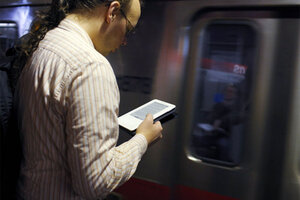Scrolling through the history of the book
The search to find out when bound books replaced scrolls leads to a new appreciation of why printed books still hold their own as a “high-tech” format.

A commuter reads on his e-reader as a subway train arrives in Cambridge, Mass.
Brian Snyder/Reuters
“Scroll codex e-book.”
It sounds like the thinking man’s version of rock-paper-scissors, doesn’t it?
Those words popped up together as I was doing some follow-up research on the word code, explored here last week.
The Latin word codex, I’d found out, gave rise to our English word code, as in a legal code. But codex also found its way into English, as a word meaning “book” – specifically, a book made up of pages stitched together. Codices (plural of codex) were what replaced scrolls.
When did that transition occur? In the 1st century: Early Christians found codices a kind of market differentiator from the Jews, who used scrolls for their important writings, including the Torah. Codices have separate pages, so both sides can be written upon. This makes codices more compact. The shift to papyrus might also have been a factor: It doesn’t roll as easily as parchment, made from animal skins.
That rolling action is what’s most essential to a scroll. Our word volume, which originally meant a roll of parchment containing writing, according to the Online Etymology Dictionary, comes from the Latin volvere, meaning to turn or to roll.
(Volvo, the name of the Swedish automaker, means literally “I roll.”)
Now back to rock-paper-scissors: It can be useful to pay attention to Google’s suggestions when you’re entering search terms. That’s how I got to the above-mentioned “scroll codex e-book.” When I entered the first two terms, Google suggested the third.
And so I found a piece by Lev Grossman, headed simply “From Scroll to Screen,” published nearly three years ago but still a top hit for people exploring the übertheme of book format.
Mr. Grossman’s point is that the shift from paper book to electronic book is not just like the shift from manuscripts (handwritten books) to books printed with movable type, but more profoundly, like the shift from scroll to codex. And then he points out just how important that shift was:
“It created a very different reading experience. With a codex, for the first time, you could jump to any point in a text instantly, nonlinearly. You could flip back and forth between two pages and even study them both at once. You could cross-check passages and compare them and bookmark them. You could skim if you were bored, and jump back to reread your favorite parts. It was the paper equivalent of random-access memory, and it must have been almost supernaturally empowering.”
Note that nonlinear reading is different from a search function – which is where e-books have an edge. But it’s clear that even by the standards of digital information technology, the book – what I suppose we now have to call “the paper book” – holds its own pretty well. It’s compact, portable, and relatively inexpensive. There’s no proprietary software to buy or update. There’s no license fee. You buy a book, and it’s yours. Or you can borrow it from the public library, and return it when you’ve read it. Or you can borrow it from a friend – well, OK, that’s when it actually can get complicated.
But the paradox of the book still stands: It is by making it possible to read in “nonlinear” fashion – dipping into a text here and there, apparently at random – that the book encourages the careful reading that most fully engages with a text. By allowing for a kind of shallowness, the book makes it possible to achieve a kind of depth.

